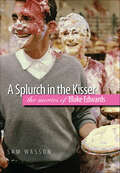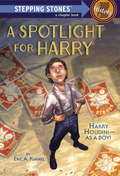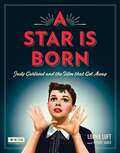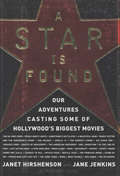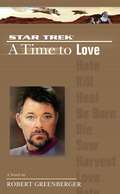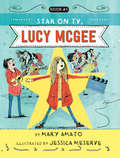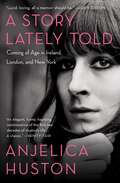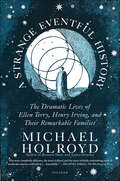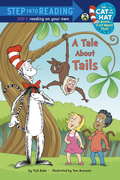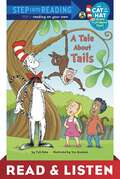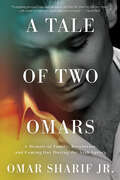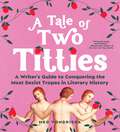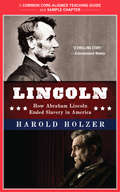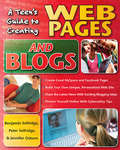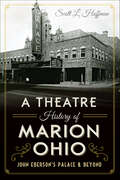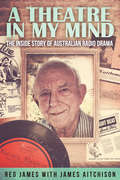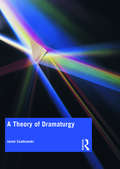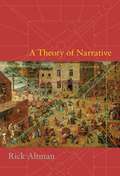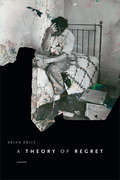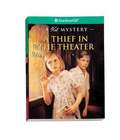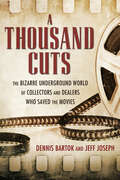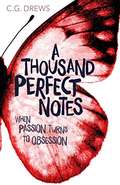- Table View
- List View
A Splurch in the Kisser: The Movies of Blake Edwards (Wesleyan Film)
by Sam WassonWith one of the longest and most controversial careers in Hollywood history, Blake Edwards is a phoenix of movie directors, full of hubris, ambition, and raving comic chutzpah. His rambunctious filmography remains an artistic force on par with Hollywood's greatest comic directors: Lubitsch, Sturges, Wilder. Like Wilder, Edwards's propensity for hilarity is double-helixed with pain, and in films like Breakfast at Tiffany's, Days of Wine and Roses, and even The Pink Panther, we can hear him off-screen, laughing in the dark. And yet, despite those enormous successes, he was at one time considered a Hollywood villain. After his marriage to Julie Andrews, Edwards's Darling Lili nearly sunk the both of them and brought Paramount Studios to its knees. Almost overnight, Blake became an industry pariah, which ironically fortified his sense of satire, as he simultaneously fought the Hollywood tide and rode it. Employing keen visual analysis, meticulous research, and troves of interviews and production files, Sam Wasson delivers the first complete account of one of the maddest figures Hollywood has ever known.
A Spotlight for Harry
by Eric A. Kimmel Jim MadsenHarry Weiss--later known as Harry Houdini--is enthralled when the circus comes to his Wisconsin town. He loves all the acts, but his favorites are the tightrope and the amazing trick where a man hangs from a rope by his teeth! Harry and his brother decide to try circus tricks in a nearby barn, and although Harry's headstrong determination leads him into trouble, it also opens up a whole new world. In this evocative story, Eric A. Kimmel tells how Harry Weiss discovered his love for performing, many years before he became world famous. History Stepping Stones now feature updated content that emphasizes Common Core and today's renewed interest in nonfiction. Perfect for home, school, and library bookshelves!
A Star Is Born: Judy Garland and the Film that Got Away (Turner Classic Movies)
by Lorna Luft Jeffrey VanceNew York Times bestselling author and daughter of Judy Garland tells the story of A Star Is Born -- at once the crowning achievement and greatest disappointment in her mother's legendary career. This is a vivid account of a film classic's production, loss, and reclamation.A Star Is Born -- the classic Hollywood tale about a young talent rising to superstardom, and the downfall of her mentor/lover along the way -- has never gone out of style. It has seen five film adaptations, but none compares to the 1954 version starring Judy Garland in her greatest role. But while it was the crowning performance of the legendary entertainer's career, the production turned into one of the most talked about in movie history.The story, which depicts the dark side of fame, addiction, loss, and suicide, paralleled Garland's own tumultuous life in many ways. While hitting alarmingly close to home for the fragile star, it ultimately led to a superlative performance -- one that was nominated for an Academy Award, but lost in one of the biggest upsets in Oscar history. Running far too long for the studio's tastes, Warner Bros. notoriously slashed extensive amounts of footage from the finished print, leaving A Star is Born in tatters and breaking the heart of both the film's star and director George Cukor.Today, with a director's cut reconstructed from previously lost scenes and audio, the 1954 A Star is Born has taken its deserved place among the most critically acclaimed movies of all time, and continues to inspire each new generation that discovers it. Now, Lorna Luft, daughter of Judy Garland and the film's producer, Sid Luft, tells the story of the production, and of her mother's fight to save her career, as only she could. Teaming with film historian Jeffrey Vance, A Star Is Born is a vivid and refreshingly candid account of the crafting, loss, and restoration of a movie classic, complemented by a trove of images from the family collection taken both on and off the set. The book also includes essays on the other screen adaptations of A Star Is Born, to round out a complete history of a story that has remained a Hollywood favorite for close to a century.
A Star Is Found: Our Adventures Casting Some of Hollywood's Biggest Movies (Read-On)
by Rachel Kranz Jane Jenkins Janet Hirshenson“These veteran insiders have a passion for casting major motion pictures, and they use meetings with famous people to illustrate how Hollywood works.” —Publishers WeeklyFor anyone who’s ever walked out of a movie and said, “That guy was all wrong for the part,” comes this first-of-its-kind look at how actors are chosen and careers are born. Two of the top casting directors in the business, who recently cast the much-lauded choice of Daniel Craig as the new James Bond, offer an insider’s tour of their crucial craft—spotting stars in the making. Janet and Jane share the fascinating, funny stories of discovering and casting then-unknown stars such as Julia Roberts, Tom Cruise, Leonardo DiCaprio, John Cusack, Matt Damon, Jennifer Connelly, Virginia Madsen, Joaquin Phoenix, Meg Ryan, Benicio Del Toro, and the Harry Potter kids. Taking us from the first casting call through head shots, auditions, meetings, and desperate searches to fill a part, they give us the kind of behind-the-scenes access to the machinery of star-making that captivates movie fans and aspiring actors alike.“In an exuberant, faultlessly pleasant manner, the authors take us behind the Hollywood curtain and into a world often misunderstood . . . remarkable reading.” —PopMatters“Parlour game fun . . . Good-natured and always professional, Hirshenson and Jenkins impart the tenets of their craft.” —The New York Times Book Review“Reads as fast and easily as a finely honed script.” —The Columbus Dispatch“Hirshenson and Jenkins have done much to demystify the process of matching actors with movie roles in this must-read for anyone interested in acting or casting.” —Booklist
A Star Trek: A Time to Love
by Robert GreenbergerOn the cusp of their epic battle with Shinzon, many of Captain Jean-Luc Picard's long-time crew were heading for new assignments and new challenges. Among the changes were William Riker's promotion to captain and his new command, Riker's marriage to Counselor Deanna Troi, and Dr. Beverly Crusher's new career at Starfleet Medical. But the story of what set them on a path away from the Starship Enterprise has never been told. UNTIL NOW. One hundred years ago, the recurring conflicts between the Bader and the Dorset ended mysteriously when both races colonized the distant planet Delta Sigma IV -- a world located far from the destructive wars of their people -- and quickly became the Federation's perfect example of interspecies cooperation. But there are now rumblings of trouble in paradise, as an investigation led by Kyle Riker -- Commander William Riker's estranged father -- into this harmonious society has discovered a shocking, immutable truth: over the next few generations, the reaction to a native gas will spell the extinction of Delta Sigma IV's inhabitants. Captain Picard and his crew, still recovering from the tragic events that have tarnished the career of one of the Federation's most decorated captains, must come to the aid of a world that once knew only peace, but now faces emerging violence and chaos...and Commander Riker must confront the reality that his own father may be held responsible for Delta Sigma IV's almost certain downfall!
A Star on TV, Lucy McGee (Lucy McGee #4)
by Mary AmatoA chance to be on TV brings out the worst in fourth grader Lucy McGee--and now her friends want her out of the Songwriting Club!Lucy McGee and Phillip Lee are invited to perform a song on their school's morning show--this is their big break! First, they agree to keep it a secret from spotlight-stealing classmate Scarlett Tandy. But what about the other members of the Songwriting Club? Lucy forgets to tell them, setting off a chain of hurt feelings, a disastrous secret party, a runaway brother, and much more. The loveable but impulsive Lucy will have to write a lot of apology letters before everything can go back to normal.The delightful Lucy McGee series features a diverse cast of fourth and fifth grade characters who all love to sing and play the ukulele in the Songwriting Club; funny and sweet illustrations on every page; and song lyrics for aspiring musicians to try out on their own. Called "Ramona-esque" by the Bulletin of the Center for Children's Books, Lucy McGee is sure to be a reader favorite.
A Story Lately Told: Coming of Age in Ireland, London, and New York
by Anjelica HustonAnjelica Huston’s “gorgeously written” (O, The Oprah Magazine) memoir is “an elegant, funny, and frequently haunting reminiscence of the first two decades of her life…A classic” (Vanity Fair).In her first, dazzling memoir, Anjelica Huston shares the story of her deeply unconventional early life—her enchanted childhood in Ireland, living with her glamorous and artistic mother, educated by tutors and nuns, intrepid on a horse. Huston was raised on an Irish estate to which—between movies—her father, director John Huston, brought his array of extraordinary friends, from Carson McCullers and John Steinbeck to Peter O’Toole and Marlon Brando. In London, where she lived with her mother and brother in the early sixties when her parents separated, Huston encountered the Rolling Stones and Fleetwood Mac. She understudied Marianne Faithfull in Hamlet. Seventeen, striking, precocious, but still young and vulnerable, she was devastated when her mother died in a car crash. Months later she moved to New York, fell in love with the much older, brilliant but disturbed photographer, Bob Richardson, and became a model. Living in the Chelsea Hotel, working with Richard Avedon and other photographers, she navigated a volatile relationship and the dynamic cultural epicenter of New York in the seventies. A Story Lately Told is an “evocative” (The New York Times), “magically beautiful” (The Boston Globe) memoir. Huston’s second memoir, Watch Me, will be published in November 2014.
A Strange Eventful History: The Dramatic Lives of Ellen Terry, Henry Irving, and Their Remarkable Families
by Michael HolroydPLEASE NOTE: THIS EBOOK DOES NOT CONTAIN PHOTOS INCLUDED IN THE PRINT EDITION.Deemed "a prodigy among biographers" by The New York Times Book Review, Michael Holroyd transformed biography into an art. Now he turns his keen observation, humane insight, and epic scope on an ensemble cast, a remarkable dynasty that presided over the golden age of theater.Ellen Terry was an ethereal beauty, the child bride of a Pre-Raphaelite painter who made her the face of the age. George Bernard Shaw was so besotted by her gifts that he could not bear to meet her, lest the spell she cast from the stage be broken. Henry Irving was an ambitious, harsh-voiced merchant's clerk, but once he painted his face and spoke the lines of Shakespeare, his stammer fell away to reveal a magnetic presence. He would become one of the greatest actor-managers in the history of the theater. Together, Terry and Irving created a powerhouse of the arts in London's Lyceum Theatre, with Bram Stoker—who would go on to write Dracula—as manager. Celebrities whose scandalous private lives commanded global attention, they took America by stormin wildly popular national tours.Their all-consuming professional lives left little room for their brilliant but troubled children. Henry's boys followed their father into the theater but could not escape the shadow of his fame. Ellen's feminist daughter, Edy, founded an avant-garde theater and a largely lesbian community at her mother's country home. But it was Edy's son, the revolutionary theatrical designer Edward Gordon Craig, who possessed the most remarkable gifts and the most perplexing inability to realize them. A now forgotten modernist visionary, he collaborated with the Russian director Stanislavski on a production of Hamlet that forever changed the way theater was staged. Maddeningly self-absorbed, he inherited his mother's potent charm and fathered thirteen children by eight women, including a daughter with the dancer Isadora Duncan.An epic story spanning a century of cultural change, A Strange Eventful History finds space for the intimate moments of daily existence as well as the bewitching fantasies played out by its subjects. Bursting with charismatic life, it is an incisive portrait of two families who defied the strictures of their time. It will be swiftly recognized as a classic.Please note: This ebook edition does not contain photos and illustrations that appeared in the print edition.
A Symphony Of Whales
by Steve Schuch Peter SylvadaGlashka can understand whale song--but with that mysterious power comes great responsibility. When she discovers thousands of whales trapped in a rapidly freezing inlet, she knows it is up to her to gather the people of her town to help them. Based on an actual event, this inspiring story follows Glashka and her people as they come to understand the importance of all life. Full-color illustrations.
A Tale About Tails (Step into Reading)
by Tom Brannon Tish RabeStep into reading with the Cat in the Hat in this leveled reader about animal tails based on an episode of the hit PBS Kids television show The Cat in the Hat Knows a Lot About That! While playing Pin the Tail on the Donkey, Sally and Nick get to wondering: What would it be like to have a tail of their own? And how would you pick the best one? Enter the Cat in the Hat. To help the kids choose, he whisks them off to the jungle to see--and try on--a variety of tails that serve different purposes: A monkey's tail that is strong for holding onto branches; a quetzal's tail that is long and colorful for attracting a mate; and a rattlesnake's tail that makes sound as a warning. Written for children who are ready to read independently, this tale about tails is a fun, funny book that introduces kids to basic comparitive anatomy!
A Tale About Tails (Step into Reading)
by Tish RabeStep into reading with the Cat in the Hat in this leveled reader about animal tails based on an episode of the hit PBS Kids television show The Cat in the Hat Knows a Lot About That! While playing Pin the Tail on the Donkey, Sally and Nick get to wondering: What would it be like to have a tail of their own? And how would you pick the best one? Enter the Cat in the Hat. To help the kids choose, he whisks them off to the jungle to see—and try on—a variety of tails that serve different purposes: A monkey's tail that is strong for holding onto branches; a quetzal's tail that is long and colorful for attracting a mate; and a rattlesnake's tail that makes sound as a warning. Written for children who are ready to read independently, this tale about tails is a fun, funny book that introduces kids to basic comparitive anatomy! This Read & Listen Edition contains audio narration.
A Tale of Two Omars: A Memoir of Family, Revolution, and Coming Out During the Arab Spring
by Omar Sharif"A powerful and essential memoir of self-discovery . . . Brimming with beautiful remembrances of his grandfather and terrifying stories of abuse and homophobia, this is an essential book that shines a much-needed light on the intersection of Arab and queer identity." —Abdi Nazemian, Lambda Literary Award–winning author of Like a Love Story, a Stonewall Honor BookThe grandson of Hollywood royalty on his father&’s side and Holocaust survivors on his mother&’s, Omar Sharif Jr. learned early on how to move between worlds, from the Montreal suburbs to the glamorous orbit of his grandparents&’ Cairo. His famous name always protected him wherever he went. When, in the wake of the Arab Spring, he made the difficult decision to come out in the pages of The Advocate, he knew his life would forever change. What he didn&’t expect was the backlash that followed. From bullying, to illness, attempted suicide, becoming a victim of sex trafficking, death threats by the thousands, revolution and never being able to return to a country he once called home, Omar Sharif Jr. has overcome more challenges than one might imagine. Drawing on the lessons he learned from both sides of his family, A Tale of Two Omars charts the course of an iconoclastic life, revealing in the process the struggles and successes that attend a public journey of self-acceptance and a life dedicated in service to others.
A Tale of Two Titties: A Writer's Guide to Conquering the Most Sexist Tropes in Literary History
by Meg VondriskaFrom the brilliantly funny (and rightfully furious) creator of the viral Men Write Women Twitter account, A Tale of Two Titties is a satirical guide to writing women like a bestselling male author.Let's face it, women's representation in literature really sucks. And that's mostly because of the male authors who write female characters like they're nothing more than playthings in their stories. Whether they have breasts like ripe peaches or curves like a racetrack, the literary ladies gracing the pages of bestselling books rarely serve a purpose beyond supporting a male character (or giving him something to fantasize about).But what are you supposed to do about it if you can't even get a foot (or, I guess, a boob) in the door?You beat them at their own game.In this hilarious yet incisive guide, you'll learn how to write women just like a bestselling male author—stereotypes, tropes, objectification, and all—so you can start dismantling the system from the inside. With thoughtful literary analysis, interactive exercises, and commentary that perfectly straddles the line between satirical hilarity and righteous indignation, A Tale of Two Titties is both an illuminating study of women's representation in literature and an absurd (yet accurate) guide to writing through the male gaze.
A Taste of Disney: Bite-Size Recipes in a Snack-Size Book
by Insight EditionsEnjoy a taste of Disney with this pocket-size cookbook of snacks inspired by your favorite animated adventures!Celebrate your love of Disney films with this adorable cookbook filled with the most delicious snacks from Insight Editions&’ bestselling Disney and Pixar cookbooks. BITE-SIZE AND DELICIOUS: Tempt your tastebuds with these simple recipes featuring everyday ingredients. Enjoy White Rabbit's Garden Crudité (Alice in Wonderland), Merida Cranachan (Brave), Bare Necessities Banana Muffins (The Jungle Book), Mug of Meat (The Emperor's New Groove), Icicle Cookies (Frozen), and so many more delicious creations to munch on! GREAT GIFT: Perfect for holidays, party hosts, birthdays—and un-birthdays, of course! It's sure to be a delight for any Disney fan BEAUTIFUL AND CUTE: This fully licensed cookbook features gorgeous recipe photos, beautiful styling, and artful appearances of the characters you love
A Taste of Disney: Sippable Recipes in a Pint-Size Book
by Insight EditionsToast your favorite Disney film with this pocket-size recipe book bursting with drinks inspired by your favorite animated adventures!Soak up this adorable recipe book featuring gorgeous, tasty nonalcoholic recipes for delectable drinks from Insight Editions&’ full line of Disney and Pixar best-selling cookbooks. EASY AND DELICIOUS: Raise a glass to this recipe book filled with simple instructions featuring everyday ingredients to brew up delicious drinks for all ages. Enjoy Lu'Au Blue Hawaiian (Lilo & Stitch), Black Forest Hot Cocoa (Snow White and the Seven Dwarfs), Growth Potion (Alice in Wonderland), Tiana Mardi Gras Smoothie (Princess and the Frog), and so many more drinks to sip and savor GREAT GIFT: Perfect for holidays, party hosts, birthdays—and un-birthdays, of course! It's sure to be a delight for any Disney fan BEAUTIFUL AND CUTE: This fully licensed cookbook features gorgeous recipe photos, beautiful styling, and artful appearances of the characters you love
A Teacher's Guide to Lincoln
by Harold Holzer Amy JurskisFor teachersWe know that the Common Core State Standards are encouraging you to reevaluate the books that you assign to your students. To help you decide which books are right for your classroom, each free ebook in this series contains a Common Core-aligned teaching guide and a sample chapter.This free teaching guide for Lincoln: How Abraham Lincoln Ended Slavery in America by Harold Holzer is designed to help you put the new Common Core State Standards into practice."The book is a delight, written for young people who may be discovering Lincoln and the Civil War for the first time. . . This may be the book that brings along a whole new generation of Lincoln fans."--Washington PostHow did President Abraham Lincoln come to believe that slavery was "morally wrong," and that Congress needed to pass a law to abolish it once and for all? What did he do in January 1865--three months before he was assassinated--to ensure passage of the Thirteenth Amendment?This fast-paced, riveting book answers these questions and more as it tells the story of Lincoln's life and times from his upbringing in Kentucky and Illinois, through his work as a lawyer and congressman, to his candidacies and victory in two Presidential elections. It also describes Lincoln's duties in the Civil War as Commander-in-Chief, his actions as President, and his relationships with his family, his political allies and rivals, and the public who voted for and against him. Harold Holzer makes an important era in American history come alive for readers of all ages.An official companion to Steven Spielberg's Oscar Award-winning film Lincoln, the book also includes thirty historical photographs, a chronology, a cast of characters, texts of selected Lincoln writings and speeches, a bibliography, and a foreword by the author about his experience working as a consultant on the movie.
A Teen's Guide to Creating Web Pages and Blogs
by Benjamin Selfridge Peter Selfridge Jennifer OsburnWhether using a social networking site like MySpace or Facebook or building a Web page from scratch, millions of teens are actively creating a vibrant part of the Internet. This is the definitive teen's guide to publishing exciting web pages and blogs on the Web. This easy-to-follow guide shows teenagers how to: Create great MySpace and Facebook pages Build their own unique, personalized Web site Share the latest news with exciting blogging ideas Protect themselves online with cyber-safety tips Written by a teenager for other teens, this book leads readers step-by-step through the basics of web and blog design. In this book, teens learn to go beyond clicking through web sites to learning winning strategies for web design and great ideas for writing blogs that attract attention and readership.
A Theatre History of Marion, Ohio: John Eberson's Palace And Beyond (Landmarks)
by Scott L. HoffmanOne of the last remaining atmospheric theatres in the nation, elegant Marion Palace Theatre holds a storied history behind its curtains. From the "Wigwam," the Grand Opera House and Germania Park Pavilion to nickelodeons, vaudeville houses and movie theatres, performance has been an essential part of Marion's history, and the Palace is the city's jewel. Designed by renowned theatre architect John Eberson, the Palace opened its doors in 1928 to packed audiences of over three thousand patrons. Author Scott L. Hoffman delves into the life and work of John Eberson and the forgotten stories of the Palace that include a police gambling raid, the construction of the theatre and the stars who performed for dazzled audiences there.
A Theatre in my Mind
by James Aitchison Reg JamesRadio drama is often called the "theatre of the mind", wherein a listener's imagination is stimulated by voices, sounds, and music to create mental imagery as real as any bricks-and-mortar theatre. Reg James spent a lifetime in the thick of Australian radio drama. Rising through the ranks at Grace Gibson Radio Productions -- from despatch boy to general manager -- he takes us behind the scenes into the fascinating world of broadcasting from the 1930s to the present day. The great shows, the magic voices, the pure drama of putting shows to air -- Reg shares his secrets and stories in this amazing journey back in time to a lost era. With co-author James Aitchison, Reg invites you to join him in this unique theatre. Essential reading for anyone who enjoyed listening to radio serials, and for those fascinated by Australian radio. Authors of Yes, Miss Gibson, the biography of Grace Gibson.
A Theory of Dramaturgy
by Janek SzatkowskiA Theory of Dramaturgy is the first text of its kind to define concepts and combine arguments into a coherent dramaturgical theory supported by an operative systems theory. This is a wide-ranging theory with historical and contemporary perspectives on dramaturgy, rather than simply a how-to book. Dramaturgy began in ancient Greece, born from experimentation with democracy and commentary in the theatre on the human condition. The term itself has seen constant evolution, but thanks to its introduction into common English usage within the last three decades, it has gained new importance. Dramaturgy draws focus to the communication of communication, and in theatre it examines how moving bodies, voice, sound, and light can tell a story and affect values. Beyond the theatre, in daily life, dramaturgy becomes a question of "performativity", as we constantly have to act in relation to the roles that we occupy. It is because of this that the way in which society describes itself to itself is not just a matter for scientists and theorists, but for all of those who are met on a daily basis with devised, staged, and directed versions of important values and events in our contemporary lives. Ideal for both scholars and students, A Theory of Dramaturgy explains how to approach the values, strategies, and theories that are essential to understanding arts and media, and investigates what art should do in the current world.
A Theory of Narrative
by Rick AltmanNarrative is a powerful element of human culture, storing and sharing the cherished parts of our personal memories and giving structure to our laws, entertainment, and history. We experience narrative in words, pictures, and film, yet regardless of how the tale is told, story remains independent from the media that makes it concrete. Narrative follows humans wherever they travel and adapts readily to new forms of communication. Constantly evolving and always up-to-date, narrative is a necessary strategy of human expression and a fundamental component of human identity.In order to understand human interaction, award-winning scholar Rick Altman launches a close study of narrative's nature, its variation in different contexts, and the method through which it makes meaning. Altman's approach breaks away from traditional forms of analysis, identifying three basic strategies: single-focus, dual-focus, and multiple-focus. Unpacking an intentionally diverse selection of texts, Altman demonstrates how these strategies function in context and illustrates their theoretical and practical applications in terms of textual analysis, literary and film history, social organization, religion, and politics. He employs inventive terminology and precise analytical methods throughout his groundbreaking work, making this volume ideal for teaching literary and film theory and for exploring the anatomy of narrative on a more general level.
A Theory of Regret
by Brian PriceIn A Theory of Regret Brian Price contends that regret is better understood as an important political emotion than as a form of weakness. Price shows how regret allows us to see that our convictions are more often the products of our perceptual habits than the authentic signs of moral courage that we more regularly take them to be. Regret teaches us to give up our expectations of what we think should or might occur in the future, and also the idea that what we think we should do will always be the right thing to do. Understood instead as a mode of thoughtfulness, regret helps us to clarify our will in relation to the decisions we make within institutional forms of existence. Considering regret in relation to emancipatory theories of thinking, Price shows how the unconditionally transformative nature of this emotion helps us become more sensitive to contingency and allows us, in turn, to recognize the steps we can take toward changing the institutions that shape our lives.
A Thief In The Theater: A Kit Mystery (American Girl Mysteries)
by Sarah Masters BuckeyIn 1935, while preparing to write a newspaper story about a theater production of Macbeth in her hometown of Cincinnati, twelve-year-old Kit discovers that a thief is stealing from the box office.
A Thousand Cuts: The Bizarre Underground World of Collectors and Dealers Who Saved the Movies
by Dennis Bartok Jeff JosephA Thousand Cuts is a candid exploration of one of America's strangest and most quickly vanishing subcultures. It is about the death of physical film in the digital era and about a paranoid, secretive, eccentric, and sometimes obsessive group of film-mad collectors who made movies and their projection a private religion in the time before DVDs and Blu-rays. The book includes the stories of film historian/critic Leonard Maltin, TCM host Robert Osborne discussing Rock Hudson's secret 1970s film vault, RoboCop producer Jon Davison dropping acid and screening King Kong with Jefferson Airplane at the Fillmore East, and Academy Award-winning film historian Kevin Brownlow recounting his decades-long quest to restore the 1927 Napoleon. Other lesser-known but equally fascinating subjects include one-legged former Broadway dancer Tony Turano, who lives in a Norma Desmond-like world of decaying movie memories, and notorious film pirate Al Beardsley, one of the men responsible for putting O. J. Simpson behind bars. Authors Dennis Bartok and Jeff Joseph examine one of the least-known episodes in modern legal history: the FBI's and Justice Department's campaign to harass, intimidate, and arrest film dealers and collectors in the early 1970s. Many of those persecuted were gay men. Victims included Planet of the Apes star Roddy McDowall, who was arrested in 1974 for film collecting and forced to name names of fellow collectors, including Rock Hudson and Mel Tormé. A Thousand Cuts explores the obsessions of the colorful individuals who created their own screening rooms, spent vast sums, negotiated underground networks, and even risked legal jeopardy to pursue their passion for real, physical film.
A Thousand Perfect Notes
by C.G. DrewsAn emotionally charged story about the power of dreams, and how passion can turn to obsession.Beck hates his life. He hates his violent mother. He hates his home. Most of all, he hates the piano that his mother forces him to play hour after hour, day after day. He will never play as she did before illness ended her career and left her bitter and broken. But Beck is too scared to stand up to his mother, and tell her his true passion, which is composing his own music - because the least suggestion of rebellion on his part ends in violence.When Beck meets August, a girl full of life, energy and laughter, love begins to awaken within him and he glimpses a way to escape his painful existence. But dare he reach for it?Thrilling and powerfully written, this is an explosive debut for YA readers which tackles the dark topic of domestic abuse in an ultimately hopeful tale.
